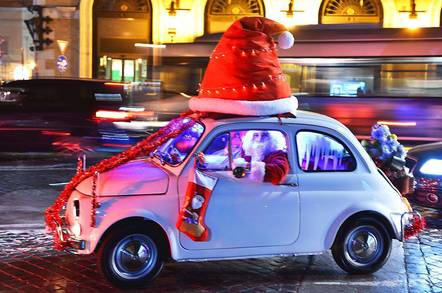 While La Bafana, the good Christmas Witch is something only found in Italy, Santa is really the same all over the world, but in Italy, his name is Babbo Natale--Daddy Christmas. Babbo Natale is who we call Santa Claus in the States, or Saint Nick or more formally, Saint Nicholas, but his roots are in many European countries' traditional folklore. To the French, he is Pere Noël (Father Christmas), Father Christmas in England, Julenisse (Christmas Elf) in Scandanavia , Sinterklaas in the Netherlands, and Sankt Nikolaus or Weihnachtsmann in Germany. All children know that Santa Claus comes from the North Pole, is bearded and overweight and that on Christmas Eve brings presents to children around the world traveling on a sleigh pulled by reindeer. They also know that he is magic--the reason why he can pull off this time-stopping feat, somehow getting into each and every house, whether or not it has a chimney. But the idea of Santa Claus was really born on the shores of the Mediterranean, evolves later on in Northern Europe and assumes its final form (Santa Claus) in the New World as an advertising gimmick. Santa Claus, as we know him today in American, was made popular throughout the world by Coca Cola ads and Clement Moore's story "A Visit from St. Nicholas" ('Twas the Night Before Christmas) so there are many similarities. They all are kind and give presents. Most wear red. Some are fat and short, others are thinner and taller. Santa has a sleigh pulled by eight reindeer, and so does Babbo Natale. Their names are a bit different, though: Cometa, Ballerina, Fulmine, Donnola, Freccia, Saltarello, Donato, Cupido (in place of our Comet, Dancer, Dasher, Prancer, Vixen, Donder, Blitzen, Cupid). In reality, in the beginning there was St. Nicholas, a greek born around 280 AD who became bishop of Myra, a Roman town in the south of Asia Minor (modern day Turkey). Nicholas earned a reputation as a fierce defender of the Christian faith in the years of persecution and spent many years in prison. None of the early representations of St. Nicholas look fat and jolly. As recently proven by forensic anthropological studies of the saint's actual remains resting in a cathedral in Bari, Puglia, Nicholas was an thin, old man, with olive skin, a broken nose with a beard and gray hair. So much for that jolly, red nose and rosey cheeks.
1 Comment
Your comment will be posted after it is approved.
Leave a Reply. |
Categories
All
Archive
June 2024
|








 RSS Feed
RSS Feed
